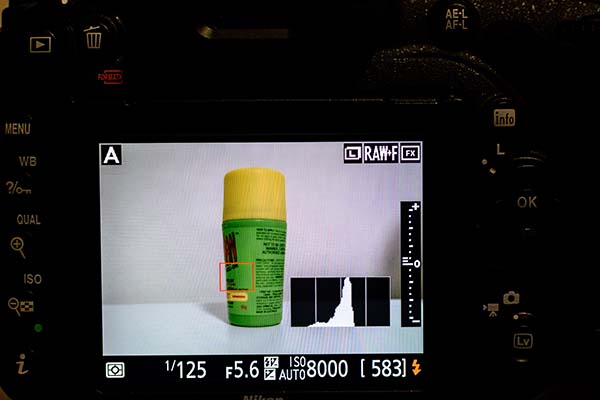What is the camera’s optical viewfinder?
The viewfinder is a rectangular eyepiece in DSLR cameras that shows the photographer the area of the subject that will be included in a photograph. In modern cameras, it usually is part of a direct visual focusing system and be used to display exposure settings and meter information.

Mirrorless cameras have a different type of viewfinder called electronic viewfinder.
What is the live view in DSLR cameras?
Live View is a function found in DSLR cameras that shows you exactly what the camera sees at any time on the LCD screen at the back of your camera.
In Live View, the mirror is moved up out of the way and the shutter is opened, thus allowing light to pass through to the camera’s sensor. Then the view of the scene is displayed live on the rear LCD display.

Live view vs viewfinder, which is better?
There are many reasons that DSLR cameras have both live view function and optical viewfinder. The live view is better in some situations and viewfinder is better in other situations.
Rather than debating about which one is better, we will see the pros and cons of them and when to use them to get maximum benefits.
Optical viewfinder advantages.
- Optical viewfinder doesn’t consume power. So, your camera battery will last longer while shooting. I am able to take up to 1500 images with one fully charged battery in my Nikon D750 camera. It is a great thing when you need to take lots of images continuously, such as in a wedding, without changing the battery.
- It allows you to hold the camera in a stable position. When you hold the camera with your hands and look through the viewfinder, the camera touches your face. So, you have 3 point contact with the camera.
- It is quick and easy to compose through the viewfinder. The scene will look as it is and there won’t be any color or brightness changes. A more accurate representation of what the human eye sees.
- The autofocus is faster when you use the viewfinder. It is a major advantage when photographing fast-moving subjects.
- There is only a minimal lag time between the shots. So, you don’t need to miss an important moment.
- Less pain in your arms. Think you are photographing an event for several hours with a heavy lens such as 70-200mm f 2.8 handholding. If you don’t use the viewfinder, your arms will get tired and painful. It is due to your arms position when using the live view.
- If you normally wear glasses, you don’t need to wear them while using the viewfinder. Instead, you can adjust the diopter setting in the viewfinder.
Optical viewfinder disadvantages.
- Beginners may find it slightly difficult to use. You may be used to the pretty smartphone screen. So, you will prefer to use the LCD at the back of your camera.
- Most consumer-grade DSLR optical viewfinders don’t cover 100% of the scene that you are shooting. They may cover only 90-95% of the view.
- You may not get autofocus points in the entire viewfinder. The autofocus points may cover only 60% of the scene. In this situation, you should use the focus and re-compose technic.
- Autofocus may not be super accurate when using the optical viewfinder.
Advantages of using live view
- The autofocus points cover the entire scene. So, it is easy to focus anywhere in the frame. You don’t need focus and re-compose.
- The autofocus is more accurate when you use the live view. Even you can zoom in the image on the LCD and manually adjust the focus.
- You can view the histogram on the LCD screen before pressing the shutter button. It is a great feature in modern DSLR cameras. You can adjust the exposure according to the histogram then take the picture.
- You can shoot holding the camera above or below the eye level. If you have a camera with a tilt screen, you will find how easy it to take photos at deferent hights without bending, leaning or climbing.
Disadvantages of live view
- The LCD monitor in your came consumes lots of power. In addition, your camera’s sensor will be working while using the live view. That also consumes power. So, you will get significantly less number of images per charge of the camera battery.
- The camera holding position is not stable when using the live view. If you have shaky hands, you will need faster shutter speeds to get sharp images. It is difficult in low light situations.
- It is difficult to see the LCD screen in bright sunlight.
- The brightness of the LCD can mislead you about the correct exposure.
- The camera’s sensor will be on while using the live view. When you shoot for long hours, the sensor will overheat. It will produce more noise and hotspots in the images.
- There will be a significant lag time between the shots. You may miss an important moment due to that.
When to use the optical viewfinder?
- Using the optical viewfinder is the recommended method when shooting a wedding or an event. It gives you longer battery running time and quick shutter release whenever you need it.
- When photographing fast-moving subjects. You should use the viewfinder when shooting sports, dance, or birds in flight. It is easy to compose the subject as it is moving and the autofocus will be fast enough.
- When shooting handheld in low light situations. You will need a slower shutter speed in this situation, so you need to hold the camera steady.
- Whenever you need a slower shutter speed without using a tripod.
- In bright light when you can’t clearly see the LCD screen.
When to use the live view on your camera?
- When you are taking landscape photos using a tripod. You will have enough time to compose and review the histogram on the LCD before taking a landscape photo.
- When you take macro photos using a tripod or flash. It is easy to zoom in the image on the LCD and manually focus on the small subjects. You don’t need to worry about camera shake when using the flash.
- You need to use the live view on a tilt screen when shooting above the eye level or very low levels. You don’t need to lie down on the ground to take a photo.
- Using the live view with eye-tracking autofocus is a great way of taking handheld portraits. You don’t need to bend down to get the correct shooting angle.
- Live view is the only option when you shoot video with your DSLR.
Bottom line:
Optical viewfinder and LCD live view are two different features found in most DSLR cameras. Knowing when to use these features will make your life easy as a photographer.

About the author: Victor is a freelance photographer, technophile, and founder of vxanswers.com.
